HydroPoetics is now in residence in the Martian House Bristol until the end of October 2022. The work will be developed through a research project Growing Liveable Worlds: Ethical encounters between human and plant life - with academics and PhD students from the University of Bristol.
Building a Martian House is a public artwork and collaboration between Ella Good & Nicki Kent, exploring what it means to live on Mars. Through doing so, the project providies a lens on how we can live sustainably here on Earth. It provides a critical framework to consider questions regarding materials and resources used in hydroponic systems: https://buildingamartianhouse.com








